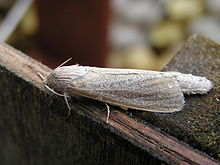| Phragmataecia | |
|---|---|

| |
| Reed leopard (Phragmataecia castaneae) | |
| Scientific classification | |
| Domain: | Eukaryota |
| Kingdom: | Animalia |
| Phylum: | Arthropoda |
| Class: | Insecta |
| Order: | Lepidoptera |
| Family: | Cossidae |
| Subfamily: | Zeuzerinae |
| Genus: | Phragmataecia Newman, 1950 |
| Species | |
|
See text | |
| Synonyms | |
| |
Phragmataecia is a genus of moths belonging to the family Cossidae. Members of this genus are found throughout the world apart from North America.
Description
[edit]Members of this genus are generally medium-sized with very long abdomens, especially in females, and long bipectinate antennae. In males the length of pecten abruptly shortens to the distal part of tip, while in females pecten length is short to the tip of antenna as near invisible papilla. Coloration is white to black with unexpressed wing patterns except small black dots between the vein of the forewing in females.[1]
Distribution
[edit]The genus consists of 39 species distributed in the Old World excluding the Papuan and Australian ranges.
Species
[edit]- Phragmataecia albida
- Phragmataecia andarana
- Phragmataecia anikini
- Phragmataecia annapurna
- Phragmataecia brunni
- Phragmataecia castaneae
- Phragmataecia cinnamomea
- Phragmataecia dushman
- Phragmataecia furia
- Phragmataecia fusca
- Phragmataecia fuscifusa
- Phragmataecia geisha
- Phragmataecia gummata
- Phragmataecia gurkoi
- Phragmataecia hummeli
- Phragmataecia impura
- Phragmataecia innominata
- Phragmataecia innotata
- Phragmataecia irrorata
- Phragmataecia itremo
- Phragmataecia laszloi
- Phragmataecia longivitta
- Phragmataecia minima
- Phragmataecia minor
- Phragmataecia monika
- Phragmataecia okovangae
- Phragmataecia pacifica
- Phragmataecia parvipuncta
- Phragmataecia pectinicornis
- Phragmataecia pelostema
- Phragmataecia psyche
- Phragmataecia purpureus
- Phragmataecia pygmaea
- Phragmataecia roborowskii
- Phragmataecia saccharum
- Phragmataecia sericeata
- Phragmataecia sumatrensis
- Phragmataecia terebrifer
- Phragmataecia turkmenbashi
References
[edit]- ^ Description of two new species of Cossidae (Lepidoptera) from China
 This article incorporates text available under the CC BY 3.0 license.
This article incorporates text available under the CC BY 3.0 license.
External links
[edit]- Beccaloni, G.; Scoble, M.; Kitching, I.; Simonsen, T.; Robinson, G.; Pitkin, B.; Hine, A.; Lyal, C., eds. (2003). "Phragmataecia". The Global Lepidoptera Names Index. Natural History Museum. Retrieved April 23, 2018.
Well, that’s interesting to know that Psilotum nudum are known as whisk ferns. Psilotum nudum is the commoner species of the two. While the P. flaccidum is a rare species and is found in the tropical islands. Both the species are usually epiphytic in habit and grow upon tree ferns. These species may also be terrestrial and grow in humus or in the crevices of the rocks.
View the detailed Guide of Psilotum nudum: Detailed Study Of Psilotum Nudum (Whisk Fern), Classification, Anatomy, Reproduction